1867 – Location of the Durfee & Peck Trading Post Store at Ft. Union, D.T.
By the time the Durfee & Peck trading post was established at Ft. Union, the days of glory for old Fort Union were long since past. More furs were being shipped from further west; gold had been discovered further west in Idaho and Montana. Fort Benton had become the new hub of the fur trade. Scores of steamers traveled the Missouri.
In June of 1867 ex-Ft. Union bourgeois Charles Larpenteur returned to Fort Union on board steamship Jeannie, as a trader representing the firm of Durfee and Peck. He and his men built a trading post just outside of the log palisade fort which was the fur trading business of the North West Fur Company.
The Durfee & Peck store was under construction during the month of June of 1867, the construction being supervised by Larpenteur. The 96 foot by 20 foot D&P store was constructed of adobe brick just outside of the palisade, and west of the fort. The D&P adobe trading post also had a bastion, and some out-buildings, including a kitchen. The adobe D&P store opened for business on July 1, 1867 at Ft. Union. It remained in business only about 40 days before the move to Ft. Buford began.
Larpenteur noted that on August the 7th 1867, the soldiers began to tear down the recently purchased Fort Union. Larpenteur started to move all the Durfee & Peck stock of trading goods, furs, hides and furnishings from the Ft. Union adobe buildings, to the new building at Ft. Buford on August 10th, 1867. The “new” D&P store at Ft. Buford was still not complete, from late October until November 1867. Larpenteur and his engagés were busy hauling sawn lumber, goods, timber and pelts to the new location at Buford. The Buford store, being 120 feet long, was complete by November 25th, 1867.
The North West Fur Co. maintained clerks at their Ft. Union trading post until September 26th, 1867, when they also moved to Fort Buford.
Durfee & Peck were in competition not only with the owners of Ft. Union (North West Fur Company), but another Indian trader group: Gregory, Bruguier and Geowey (GBG) who had two small rude wooden buildings east of the main fort structure. This made a total of three different fur and hide trading companies represented at this one location during the summer of 1867, GBG one the east, D&P on the west and North West Fur Company operating the main fort.
During the summer of 1867 the Ft. Union location of D&P under Larpenteur did a great business, even with the mayhem of new construction and moving from Union to Buford in August. They acquired two thousand buffalo robes, 900 elk hides, 1,800 deer skins, and 1,000 wolf skins. This rosy picture did not last long, as the management of D&P fired Larpenteur when they arrived by steamboat on May 18, 1868.
Fort Buford, Dakota Territory
By the start of the Civil War in the early 1860s, Ft. Union was 30 years old, and General Alfred Sully described Ft. Union as “an old dilapidated affair, almost falling to pieces.” So the Army decided a new larger fort should be established, close to Ft. Union, but at a better site, considering flooding, water wells, defensibility and accessibility from the river. General Sully arrived at Ft. Union with Company I, 30th Wisconsin Infantry which were garrisoned there to guard the fort, and supplies.
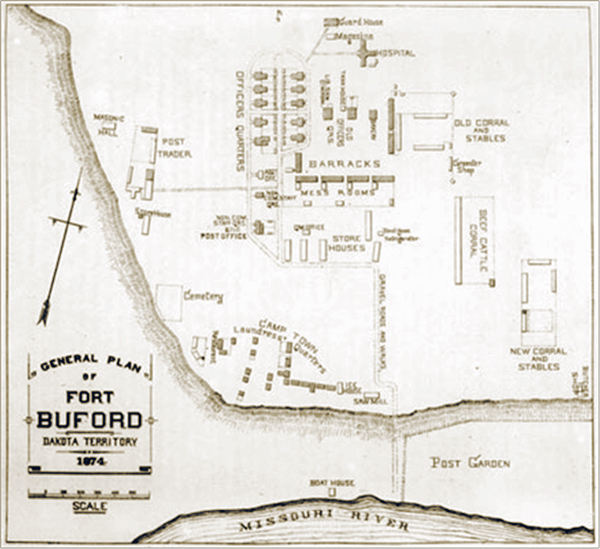
Ft. Buford, D.T. was established on June 15, 1866. It was located on the north bank of the Missouri River, just below the confluence of the Yellowstone and Missouri Rivers. Ft. Buford was about 2 1/2 miles from the earlier Fort Union. The post was intended to protect the emigrant route from Minnesota to Montana, and guard the commercial navigation along the Missouri River. Fort Buford was conceived, built and operated as a military fort for the U.S. Army. It is possible that Durfee and Peck held a “post trader” license at Ft. Buford, as it is verified that D&P did in fact hold military post trader licenses at some locations (unverified by me which locations).
Fort Buford was named for Major General John Buford (of Gettysburg fame) who died December 16, 1863. Ft. Buford was established by Brevet Lieutenant Colonel William G. Rankin commander of Company C, 13th U.S. Infantry (the 13th Infantry became the 22nd Infantry in the reorganization of 1867), on a site selected by Major General Alfred H. Terry. Fort Buford had outlived its main purpose by the 1890s, and was abandoned on October 1, 1895. The garrison was transferred to Fort Assiniboine, Montana. A small contingent of troops remained at the site as it was closed down until November 7, 1895. The site was transferred to the Department of the Interior on October 31, 1895.
Ft. Buford was planned as a rectangle, 333 yards by 200 yards, surrounded by a 12 foot high wooden stockade on three sides. The side facing the river was not stockaded. The barracks buildings were of adobe brick, the remaining buildings were made from cottonwood. I was unable to determine the cutoff date of the Durfee & Peck store at Ft. Buford, however the fort itself was abandoned in 1895. Since Mr. Durfee died in 1875, I would say the approximate date for use for the tokens at Ft. Buford was from 1867 thru 1875.
The Advantage of the Location for Buffalo Trade
The big advantage of the location of Ft. Union, D.T. as a receiving point for buffalo hides in 1868, was that it was smack on the Missouri River, and indeed at near the headwaters of that river. Therefore, any bison robes received at this point, could simply be loaded on one of the steam packet boats, and head downriver, to the markets in St. Louis. In this regard, Durfee and Peck had a big advantage over most of the trading posts of the Hudson’s Bay Company, who had to ship any hides or pelts overland to their York factory.
 The Value of 25-Cents in 1868
The Value of 25-Cents in 1868
The Durfee & Peck tokens were issued in 25 cent, 50 cent and $1.00 denominations. Adjusting for inflation, the 25 cents of 1868 would be worth about $4.48 in today’s goods. Multiply that by two and four and you have the other two tokens adjusted worth in goods.
Dakota Territory in 1868 – Temperatures – Geography – History
At first Dakota Territory was comprised of South Dakota, North Dakota along with parts of Wyoming, Montana and Idaho. In 1868, Montana and Wyoming each became separate territories. Average temperature during a year at the site of Fort Union is 37 degrees F. The coldest month is January with average temperature of 2 degrees; warmest is July with average temperature of 67 degrees F. Average snowfall per year at the Fort Union site is 31 inches; average total precipitation per year is about 16 inches.
Indian Tribes of the Area
Fort Union, Dakota Territory was built specifically to serve the Assiniboine (pronounced Uh-sin-uh-boin) tribe. The Assiniboine tribe was the most important tribe of the upper Missouri River. The fort was built on their land. There were 9 main tribes in the area of Fort Union. I have prepared a chart, indicating the tribes in order of most to least important:
The Indian tribes in the area were devastated by a smallpox epidemic in 1837, up to 90% of the Mandan and Hidatsa tribes were killed by the epidemic. Inoculation were attempted, but proved unsuccessful.
The Reason for Separate D&P Tokens and E.H. Durfee Tokens
Below you will read that E. H. Durfee by himself controlled the “southern trade” with the Plains Indian tribes, while a different business venture partnered him with Mr. Peck to trade with the “northern trade.”
The following quote is taken from the May 8, 1868 “Leavenworth Daily Conservative” newspaper, concerning the firm of Durfee & Peck, and the buffalo hide trade:
“Probably there is no business carried on in this country of which so little is known by the public generally as Indian trading. We yesterday had a very interesting chat with Mr. E. H. Durfee, one of the oldest and most widely known Indian traders who have ever been about the business, which we have decided to lay before our readers.”
The Southern Trade
He is the sole proprietor of the establishment here, which is the headquarters for the traffic with the Southern Indians. The posts on the upper Missouri are owned by Durfee & Peck. The Southern Indians, or those south of the Arkansas, supplied, are the following, with their estimated numbers: Comanches, 23,600; Apaches and Cheyennes, 3,500; Osages and Kaws, 4,000. The larger tribes, as nearly everybody knows, are divided into bands, under various names, which we will not give here.
The Northern Trade
The Indians of the North with which they trade are all Sioux, numbering, it is estimated, upwards of 70,000. They are located in Dacotah (sic) and Montana. The Sioux are divided into twelve or fifteen bands. Some of their trade comes from the British Possessions, and the whole extent of it is from there to Texas. The only rival of Durfee & Peck is the Northwestern Fur Company. The competition is sharp, and is carried on with all the energy which characterizes the Yankee everywhere in Wall street or in a log cabin a thousand miles from civilization.
 The Posts, and Men Employed
The Posts, and Men Employed
Durfee & Peck have employed at their posts, in all, about one hundred men. A large number of these are fitted out every season by them with arms and traps with which they get their furs and turn them over to their employers, receiving therefore goods, which they in turn sell to the Indians.
They have on the upper Missouri seven posts, at which are stored and kept for sale all kinds of goods which the Indians want to buy, and where they come in with their skins. The houses used are all built of logs, with mud roofs, saw mills being scarce up that way.
The Hunting and Trapping Season
The season in which furs and peltries are secured by the hunters and trappers is from October to February. After that time the shedding of the coat commences and the hair fades and becomes worthless. The animals most sought for and which produce the most desirable skins are the following, placed in the order of value: Otter, beaver, buffalo, wolf, elk, bear, fox, deer, and coon. Mink is considered too small game, among the Indian trappers in particular.
How They Are Killed
The buffalo are killed mostly with arrows, as they are not only less expensive, but can be withdrawn and used again. These animals are generally hunted in the following manner: A large herd is surrounded and gradually driven in together. And there is exhibited a piece of strategy thoroughly Indian. The stragglers on the outside of the main herd are shot in the liver and will bleed to death internally in going four or five miles. The hunters will keep on driving them, and the carcasses at the close of the chase are not scattered over so large an extent of ground as they would be if the stragglers were shot dead. When the circle is well closed in, the hunters begin to shoot at the heart. Their ponies are all trained and will not enter the herd, but keep always around the outside, though the rider does not draw a rein on them after the main herd is reached.
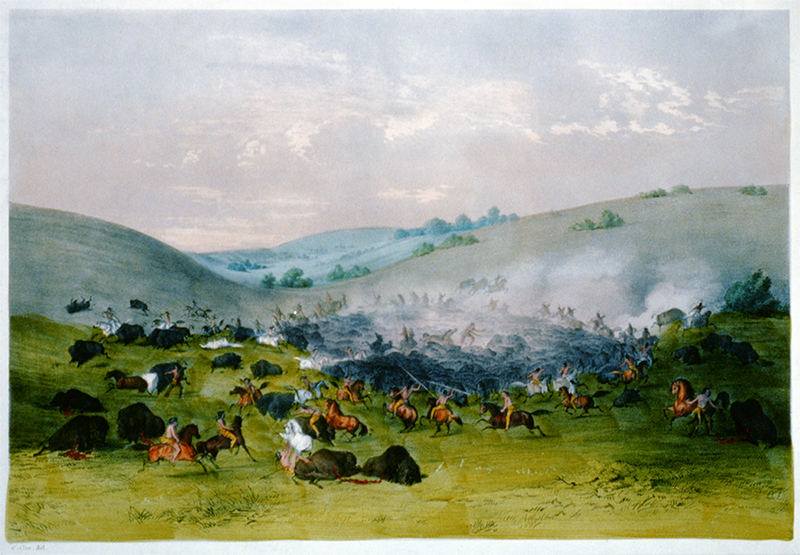
The wolves are all poisoned in the following manner: A quarter of buffalo is either taken in a wagon or dragged over the prairie; at the distance of about 40 rods apart, numerous stakes are stuck in the ground, on the top of which is impaled a small piece of the meat, which has been poisoned with strychnine. The wolves strike the trail and follow it up, taking the pieces as they go. Next morning the hunters go along the line and skin the dead animals.
Dressing and Tanning
The Indians use the brains of the animal to tan it with. They first stretch the skin over a frame. They then rub on the brains, mixed with juices obtained from certain roots and plants. They are then scraped with various implements, hoes being used. They say the brains draw out the grease. After they are dry, they are painted and ornamented. The paint used is of the very finest qualities of Chinese vermillion and chrome yellow and green. These are imported by Durfee & Peck.
Bringing in the Skins
As soon as the season is over the Indians put the hides and furs on poles, which are dragged by ponies, sometimes a distance of 300 miles, to the nearest trading post. The whole band generally comes in with them. At the posts are opposition runners, in the employ of the Northwestern Company and Durfee & Peck. They keep on the watch, and as soon as a band comes in sight they mount their ponies and start off to secure the customers. Those with whom they decide to trade are compelled by custom to give the band a great feast, which lasts one day. Then business commences.
What the Indians Buy
The articles most in demand by the red men are coffee and sugar, of which they are very fond. In dry goods they want blankets, cloth, prints; a few of them buy saddles and bridles. An ornament called an Iroquois shell, which is picked up on the seashore somewhere in Europe, is in great demand. Mr. Durfee says he has seen an Indian sell fifteen out of twenty buffalo robes for these shells.
- The Ghost Town Tokens of Thurber, Texas - June 2, 2013
- Durfee & Peck’s Indian Trader Tokens - May 19, 2013

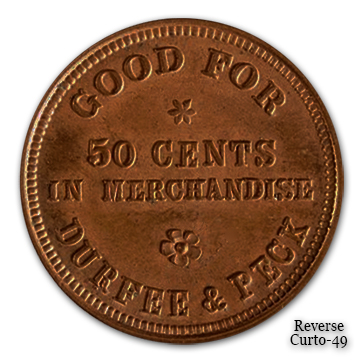
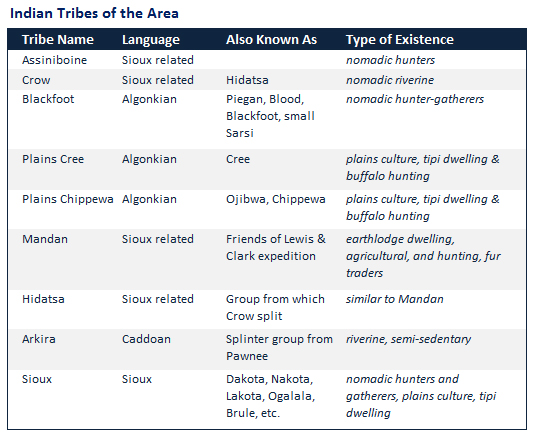
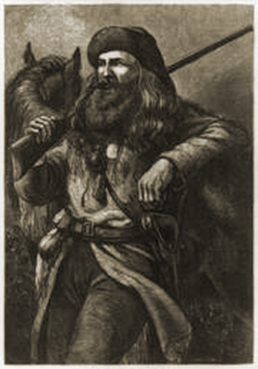
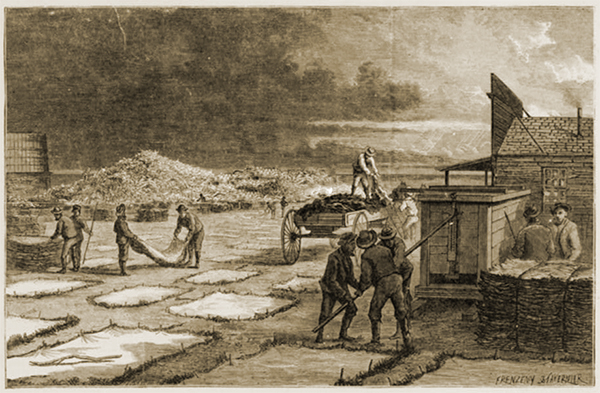

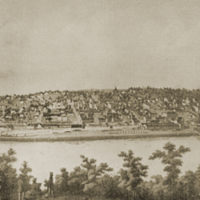
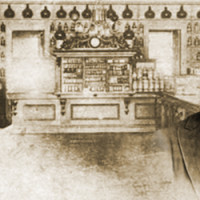
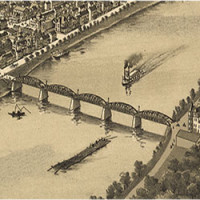
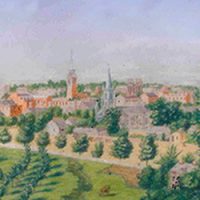
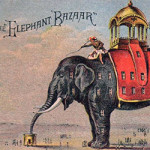
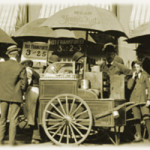
any exact dates when Fort Browning on the Milk River started to be built.